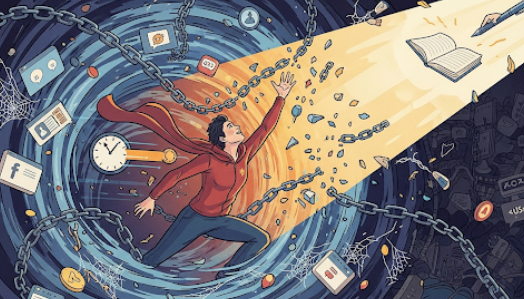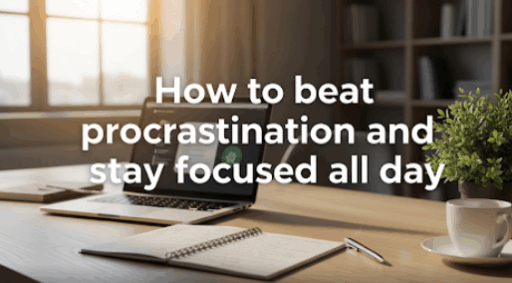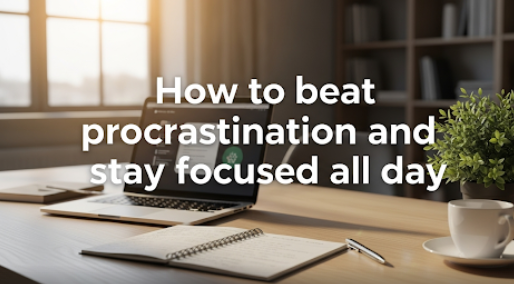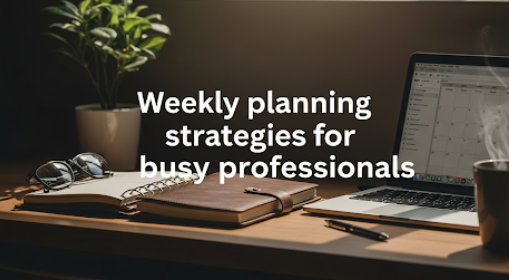Beating Procrastination and Maintaining Focus All Day Long
Procrastination hits everyone. You sit down to work, but before you know it you are scrolling through your socials, clearing up your table, or just about anything instead of what needs doing. Sound familiar? You’re not alone. For students, it is an even larger percentage (one study found 80% of college students claim to be procrastinators).
The good news? Procrastination does not define your character, and it can be defeated. This is a habit that can and should be broken, with both the right strategies and the mindset. This post will help you learn how to stop procrastinating and achieve higher levels of focus during all hours of the day, through science-backed methods that actually work.
Whether you’re a student falling behind on assignments, a young professional swimming below the proverbial deadlines or someone who simply wishes to accomplish more during every 24 hour cycle, these techniques may forever change how you see tasks and enable you to really own your time.
What Really Causes Procrastination?
But first, let’s talk about why we procrastinate before getting into solutions. Procrastination, as it turns out, has little to do with laziness or lack of willpower.
Why We Procrastinate and How to Stop
At a more fundamental level, procrastination is usually an outgrowth of deeper emotional layering:
Fear of failure: In this type, when you are afraid that a task will not go well or that you will miss the due chance to shine, your brain convinces you not even to engage in trying and thus protect yourself from possible failure.
Perfectionism: This can stop us from starting at all. Anyone else spent way too long making sure they have the correct plan to avoid any mistakes?
Getting overwhelmed: Big tasks are so big we feel we don’t know where to start
We love instant rewards: The human brain is wired for immediate, easy reward over long-term gain
Decision fatigue: We only have so much mental energy to make choices – too many of them can overwhelm us.
Common Procrastination Triggers
| Trigger | Example | Reason |
|---|---|---|
| Boring tasks | Filing paperwork, data entry | Brain craves novelty |
| Unclear instructions | Vague project requirements | Ambiguity = anxiety |
| Large projects | Writing a thesis, organizing an event | Project size reduces confidence |
| No immediate deadline | Exercise, learning new skills | Lack of timeline allows delay |
| Perfectionist tendencies | Editing the presentation repeatedly | Fear that nothing is perfect enough |
Building Your Anti-Procrastination Mindset
The wisdom of beating procrastination lies in altering the very framework we employ to understand tasks and productivity.
Shift From All-or-Nothing Thinking
One of the biggest misconceptions procrastinators believe, is that they need large swathes of time to get anything done with real impact. A perspective that makes you wait forever for the “right” moment, but it never arrives.
Rather, unleash the power of tiny steps:
- Celebrate small wins: 5 minutes of work is better than 0
- Start, don’t finish — It’s often the first step that’s most difficult
- Embrace imperfect action: Finished is better than perfect
Remember: Success loves speed, but value consistency over intensity — small daily efforts beat sporadic marathon sessions.
Reframe Your Relationship with Discomfort
We procrastinate a lot of times when we are forced to feel something we do not want to feel, like unease or anxiety. Being able to experience discomfort and not rush off into any form of escape is critical to sustainable change.
Practice these mental shifts:
- Think of boredom as a state, not an impulse — you do not necessarily have to fight this sensation
- View challenging tasks as a chance to stretch yourself rather than something to shy away from
- Understand that feeling resistance to doing the work is a natural and transitory emotion
The thing is, motivation comes after action, not before.
Smart Planning Strategies
Well, your first defense against procrastination is effective planning. Yet, most people plan incorrectly and fail before they even start.
The 3-2-1 Planning Method
This one simple system will help you to prioritize without feeling overwhelmed.
- 3 Key tasks: Top of your to-do list for the day
- 2 Medium difficulty tasks: Second-tier items you would like ticked off or move along
- 1 Short task: A small item that can be done in less than 15 minutes
This method solves both problems — you will not be overcommitted while still having an easily digestible starting point.
Time Blocking That Sticks
Traditional to-do lists often don’t work – as they fail to factor in the actual time tasks require. Time blocking helps keep you realistic with your schedule.
Here’s how to do it right:
- Be brutally honest in your estimates: Add 25–50% for buffer time
- Group similar tasks: Block emails, calls or creative work together
- Schedule breaks — Incorporate 10–15 minute breaks between concentrated work sessions
- Expect the unexpected: Allow time for interruptions
- Evaluate: At the end of each day, check out what you managed and see where things worked and went astray
The Power of Implementation Intentions
Instead of wishy-washy goals like “I’ll work out more,” make a specific if-then plan:
- Example: “If it is 7 am on a weekday, then I go and take a walk for 20 minutes.”
- “After lunch, 30 minutes of working on my project.”
- “Every time I want to check social media, I have to do 10 push ups.”
Studies have shown that using implementation intentions can increase the chances of reaching goals by 2 to 3 times.
The Two-Minute Rule and Quick Wins
The most effective anti-procrastination tactic of all might be this very simple one: If it takes less than two minutes, then do it right now.
Why the Two-Minute Rule Works
The behavior rule relies on a few psychological principles:
- Saves mental energy — you don’t spend it on deciding when to do micro-tasks
- Gets the ball rolling: When you finish tiny tasks, it boosts your satisfaction and makes you ready to tackle bigger jobs
- Avoids pile-up: Small tasks don’t grow into mountains of work
- Creates good habits: you train yourself to do rather than wait
Expanding Beyond Two Minutes
After you learn how to use the two-minute rule, slowly extend it:
- Week 1–2: Only work on real two-minute tasks
- Week 3–4: Extend to five-minute tasks
- Week 5–6: 10-minute quick wins
- Continue — Move up from this and onto bigger projects
Quick Win Categories
Recognize what tasks increase your energy rather than drain it.
Energy-giving quick wins:
- Organizing your workspace
- Responding to a friend’s message
- Updating your calendar
- Clearing your email inbox
- Making tomorrow’s to-do list
Save for high-energy periods:
- Complex problem-solving
- Difficult conversations
- Creative work requiring deep thought
- Learning new technical skills
Time Management Methods for Better Concentration
People and circumstances have distinct rhythms, so different time management methods may work better for you. These are the approaches which have been proven effective.
The Pomodoro Technique Deep Dive
This technique involves 25-minute work-focused bursts. Take a break after each Pomodoro — then, every four pomodoros take a longer 15–30 minute break.
Step-by-step implementation:
- Pick a task and start working
- Set a timer for 25 minutes
- Stay focused and work until the timer goes off
- 5 minute break (stand up, stretch and hydrate)
- Repeat for 3-4 cycles
- Take a longer break to recharge
Customizing Pomodoro for your needs:
- For deep work: 45–90 minute sessions, with 10–15 minute recovery periods
- Creative tasks: 15-20 minute bursts to keep a fresh perspective
- Routine tasks: The standard 25-minute sessions work well
- While studying: Alternate between subjects every few pomodoros
Time Boxing vs. Task Boxing
Time boxing: Fixed time periods on activities regardless of completion.
- Pros: Creates urgency; limits scope creep
- Cons: Tasks may remain incomplete; can feel rushed
- Ideal for: Creative work, research, brainstorming
Task boxing: Focus on completing specific items:
- Pros: Ensures completion, makes the ending obvious, builds momentum
- Cons: Can cause delays in schedule, can promote perfectionism
- Ideal for: Administrative tasks, errands, repetitive work
The 52-17 Method
Research from the productivity app DeskTime shows that the most productive 10% of people take a 17-minute break after every 52 minutes of work. This method works because:
- 52 minutes allows for deep, uninterrupted focus
- 17 minutes is plenty for your brain to rest
- Energy levels are kept high all day
- Breaks that are long enough help you avoid mental fatigue and the procrastination that follows
Creating Your Distraction-Free Environment
One of the major factors in why you procrastinate or stay focused is your environment. You will need to optimize your physical and digital space, which can make a massive impact on your productivity.
Physical Space Optimization
Desk setup for focus:
- Only expose the materials of the current project
- Position your monitor to prevent glare and fatigue
- Maintain comfortable temperature (most people prefer 68-72°F)
- Whenever possible, use natural light or full-spectrum LED lights
- Have water and healthy snacks around at all times to suppress hunger distractions
One-touch rule — everything in your workspace should have a home. If you’re done with something, put it away immediately rather than setting it “down” temporarily.
Digital Environment Control
Browser and app management:
- Use website blockers during focused work sessions
- Turn off non-essential notifications
- Put your phone in another room or drawer
- Create 2 different browser profiles, one for work and the other for personal browsing
- Shut down all other tabs and apps
Essential digital tools for focus:
- Forest or Freedom: Website blocker apps
- RescueTime: Shows you how you really spend time on your devices
- Toggl: Easy time tracking to identify patterns
- Noise-canceling headphones: Block environmental distractions
- White noise or focus music: For consistent auditory environment
Managing Social and Environmental Interruptions
Communication boundaries:
- Reply to emails and messages at specific times
- Enable “Do Not Disturb” modes during focused work sessions
- Let family, friends, and colleagues know when you are focused on work
- Use physical signals (closed door, headphones) indicating you are not available
Dealing with internal interruptions:
- Capture notebook: Write down stray thoughts/ideas while at work
- Jot down concerns for later
- Parking Lot method — Temporarily note any ideas that distract you and come back after your break

Daily Routines That Eliminate Procrastination
Having a routine minimizes the drain on our decision making energy and frees up more brain capacity for the tasks at hand.
Morning Routines for Productivity
Your morning sets the tone for your entire day. A planned morning routine removes decision fatigue and builds momentum.
The 3-Phase Morning Setup:
Phase 1: Physical activation (10-15 minutes)
- Light exercise or stretching
- Drink a large glass of water
- Get natural sunlight exposure
- Deep breathing / short meditation
Phase 2: Mental preparation (10-15 minutes)
- Review your daily priorities
- Visualize accomplishing your most important task of the day
- Read something inspiring or educational
- Set intention for a productive day
Phase 3: Immediate action
- Start your single most crucial task within 30 minutes of waking up
- Don’t start the day by checking your email or social media accounts
- Always start with the task you know you are going to procrastinate on
- Conserve your mental energy; save it for the harder stuff
Evening Reviews for Continuous Improvement
Having an evening routine helps you reflect upon the successes and failures of each day, while preparing yourself to succeed tomorrow.
The 5-Question Evening Review:
- What was the win today that I am proud of?
- What task did I not do, and why?
- Which environmental factors helped or hampered my focus?
- How would I approach tomorrow differently?
- What 3 things will I get done tomorrow?
This will take only 5–10 minutes but you can get a good understanding of why you procrastinate and what are the times when your productivity is high.
Weekly Planning Sessions
Spend 30 minutes per week in advance planning:
Sunday planning ritual:
- Review the upcoming week’s calendar
- Identify potential challenges or busier times
- Prepare materials for important tasks
- Set 3 major goals for the week
- Balance work time and relaxation time
Psychology Hacks: How to Trick Your Brain
Your brain follows patterns and biases. When you understand them, you can work with them.
The Zeigarnik Effect
The Zeigarnik Effect shows that our brains are naturally wired to remember incomplete tasks better than completed ones.
How to apply it:
- Begin any activity, even if you work only 2–3 minutes
- Stop at a natural breaking point (i.e. stop mid-sentence while writing)
- The unfinished work will keep lingering in your brain
- You will come back with energy and naturally want to continue
Temptation Bundling
This method pairs an activity you have to do with something you want to do.
Examples of temptation bundling:
- Listen to your favorite podcast only while working out
- Watch television while doing household chores
- Treat yourself to fancy coffee when you tackle something hard
- Set up a standing desk where you love to watch the world go by
The Fresh Start Effect
Temporal landmarks make people more likely to pursue goals and prompt behavior change.
Natural fresh start moments:
- Mondays
- The first day of a month
- Birthdays
- New Year’s Day
- The start of a new season
By no means should you wait until these dates, but if you are struggling to stick to your resolutions maybe they will help add some fuel to fight procrastination.
Technology Tools and Apps for Focus
Choose technology that can enhance your focus and make it work in your favor.
Essential Productivity Apps
Task Management:
- Todoist: Perfect for projects with powerful natural language processing
- Things 3: Best for Apple users
- Asana: Ideal for team projects and coordination
- Notion: All-in-one workspace for notes, tasks, wikis
Focus and Time Tracking:
- Forest: Gamifies focus time by planting virtual trees
- Be Focused: Focus timer & goal tracker
- Toggl Track: Time tracking with detailed reporting
- Clockify: Free time tracking for teams and individuals
Website and App Blocking:
- Cold Turkey: Complete blocking on any device
- Freedom: Cross-platform blocking with custom schedules
- StayFocusd: Chrome extension with customizable time limits
- Opal: iOS app blocking with scheduling
Creating Effective Digital Workflows
Email management system:
- Check email only at set times (morning, lunch, end of day)
- Quick responses: Follow the 2-minute rule
- Archive or delete after reading
- Use folders or labels for organization
- Unsubscribe ruthlessly from unnecessary lists
File organization strategy:
- Use consistent naming conventions for all documents
- Save to cloud storage with automatic sync
- Schedule regular digital decluttering
- Keep desktop and downloads folder clean
- Store files in project-specific folders with clear hierarchy
Advanced Strategies for Long-Term Success
These advanced techniques will keep you focused and motivated over months and years.
The Implementation Science Approach
Implementation science research has shown that successful behavior change requires:
Concrete implementation intentions: Instead of “I will work on my project” write down: “After I have my morning coffee I will open my laptop and sit at the desk for 45 minutes working on project X”.
Environmental design: Align your physical environment so that good choices are more accessible and bad choices require more effort:
- Don’t keep your phone in the same room while working
- Set out your workout clothes the night before
- Prepare healthy snacks in advance
- Set up your workspace before you need it
Social Accountability
- Tell a friend or family member about your goals
- Join like-minded online communities
- Have regular check-in calls with an accountability partner
- Use apps that allow others to follow your progress
The Energy Management Matrix
Not all hours are created equal. Categorize your daily energy levels and assign corresponding tasks to each.
High-energy times (like mornings for most people):
- Creative work
- Problem-solving
- Learning new skills
- Difficult conversations
- Complex analysis
Medium-energy periods (mid-morning, early afternoon):
- Routine tasks
- Email management
- Planning and organizing
- Research and reading
- Administrative work
Low-energy times (usually after lunch, late afternoon):
- Data entry
- Filing and organizing
- Responding to messages
- Light exercise
- Preparation for tomorrow
Building Anti-Procrastination Habits
Habit Stacking
Link new productive behaviors with habits you already do daily.
Examples:
- “I will review my top priorities first thing after my morning coffee.”
- “I’ll work on my number one priority for 25 minutes after sitting down at my desk.”
- “I am going to take a quick 10-minute walk outside after finishing lunch.”
The 1% Rule
Focus on small consistent improvements over time, not massive changes. If you procrastinate 3 hours at a time right now, do not try to become perfectly productive overnight. Instead:
- Week 1: Reduce procrastination by 15 minutes
- Week 2: Add an additional 15 minutes of focused work
- Week 3: Continue gradual improvements
- Month 2: You’ll be highly productive without burning out
Creating Accountability Systems
Self-discipline fails more often than not, so we need external accountability. Here are ways you can make accountability actually work.
Types of Accountability Partners
- The Progress Partner: Someone who checks in with you weekly about your goals
- The Body Doubling Buddy: Someone who works alongside you, even virtually
- The Mentor Figure: Someone whose opinion is valuable and whom you can turn to for guidance
- The Peer Group: A community of people working on similar goals
Self-Accountability Techniques
Progress tracking methods:
- Visual progress bars: Create charts that represent percentage of completion
- Streak tracking: Count how many days in a row you’ve completed critical habits
- Before and after photos: Document your productivity improvements
- Time logs — See where you actually spend time vs. how you planned
Reward systems that work:
- Implement instant micro-rewards for task completion
- Larger rewards for reaching weekly or monthly goals
- Reward yourself with experiences instead of purchases
- Match rewards to the effort and difficulty of each task
How to Overcome Setbacks & Keep Momentum Going
Setbacks are inevitable. The difference between long-term success and failure is what happens when things do not go according to plan.
The Bounce-Back Protocol
Every time you backslide into procrastination:
Step 1: Pause without judgment (2 minutes)
- Acknowledge what happened without self-criticism
- Remember that setbacks are part of the process
- Avoid the “what’s the point” spiral
Step 2: Identify the trigger (3 minutes)
- What specifically caused the procrastination?
- Was it environmental, emotional, or circumstantial?
- How can you avoid or prepare for this trigger in the future?
Step 3: Take immediate action (5 minutes)
- Take one small action toward your goal
- Clean or organize your workspace
- Re-evaluate your priorities and adjust if needed
Step 4: Resume your routine
- Return to your established systems
- Don’t try to “make up” for lost time
- Focus on consistency going forward
Preventing Burnout While Staying Productive
Real productivity requires respect for rest and recovery.
Warning signs of productivity burnout:
- Increased procrastination despite good intentions
- Feeling exhausted even after plenty of sleep
- Loss of interest in previously enjoyable activities
- Difficulty focusing even on easy tasks
- Increased irritability or mood swings
Prevention strategies:
- Schedule downtime — Rest is not optional
- Vary your tasks: Use different types of work to break up your day
- Stay socially connected: Productivity should not replace relationships
- Learn to say no: Protect your time and energy
- Stay physically active: Exercise improves mental endurance
Measuring Your Progress and Success
What gets measured gets managed. Tracking will remind you how far you’ve come and give insight into areas that need improvement.
Key Metrics to Track
Daily metrics:
- Number of completed work sessions
- Time spent on top priorities
- Instances of avoiding procrastination
- Energy levels throughout the day
- Sleep quality the night before
Weekly metrics:
- Percentage of planned tasks completed
- Time spent on important vs urgent tasks
- Number of deep work sessions completed
- Progress toward longer-term goals
- Overall life satisfaction and stress levels
Simple Tracking Methods
The Plus/Delta Journal: Every evening write:
- Plus: What went well today?
- Delta: How to make tomorrow better?
The 1-10 Scale: Rate yourself daily on:
- Focus quality (1 = completely distracted, 10 = laser-focused)
- Energy levels (1 = exhausted, 10 = energized)
- Procrastination level (1 = did absolutely nothing, 10 = completed everything)
- General satisfaction (1 = frustrated, 10 = accomplished)
Building Long-Term Consistency
The end game is not just one productive day, but creating systems that allow you to sustain your focus and motivation over time.
The Compound Effect of Small Actions
Small steps taken daily add up to large results. Consider these examples:
- Reading 10 pages a day equals 3,650 pages or about 12 books per year
- Writing 250 words a day averages out to one 91,000-word book finished every year
- Twenty minutes a day of exercise is 121 hours of fitness each year
- Just 30 minutes a day of skill learning is 182 hours of practice annually
Seasonal Adjustments and Life Changes
Your anti-procrastination system needs to adapt over time:
During busy periods:
- Simplify your daily obligations to stay consistent
- Focus only on the tasks that matter most
- Maintain minimum viable routines
- Ask for help when needed
During slow periods:
- Build new productive habits
- Take on bigger projects you have been putting off
- Invest time in learning and skill development
- Prepare for future busy periods
Major life transitions:
- Expect temporary disruption to routines
- Start small when rebuilding habits
- Adapt systems to new circumstances
- Seek support from others who’ve gone through similar changes
Take Action: Your Next Steps
Defeating procrastination and maintaining focus all day is not about willpower or motivation. It’s about making the right choice the easy choice, through systems, environments and habits that create conditions for productive action.
Here are three steps to take immediately:
- Choose one method from this guide and implement it tomorrow
- Optimize your environment (remove distractions and support focus)
- Track your progress for one week to see what works best for you
Remember, the goal isn’t perfection. It’s progress. Each 1% improvement builds momentum toward the intentional life you want to create. These are the same strategies that have helped thousands of people overcome procrastination.
Your future self will thank you for starting today instead of procrastinating. The best time to start was yesterday. The next best time is now.




